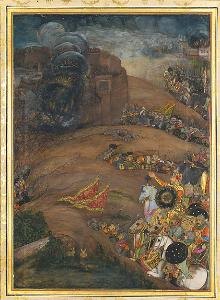Payag
Payag
Place: India
Born: 1595
Death: 1655
Biography:
Early Life and Career
Payag, an Indian miniature painter, was born in 1595 and remained active until his passing in 1655. As the older brother of the renowned Mughal artist Balchand, Payag's career likely began within the Mughal court, where he honed his skills in capturing intricate details and realism.
Artistic Style and Notable Works
Payag's artistic prowess is evident in his detailed and realistic paintings, often depicting scenes from the Mughal court and military campaigns. One of his most notable contributions was to the Padshahnama, a chronicle of the reign of Shah Jahan, now preserved in the Royal Library, Windsor Castle.
- Key Artistic Elements:
- Detailed and realistic depictions
- Mughal court and military campaign scenes
- Contribution to the Padshahnama
- Notable Works:**
- Padshahnama (Royal Library, Windsor Castle)
- Various Mughal court and military campaign scenes (collections at Wikioo.org)
Legacy and Influence
Payag's work, though lesser known compared to his brother Balchand, signifies the artistic excellence of 17th-century Indian miniature painting. His contributions to the Padshahnama and other Mughal court depictions have solidified his place in art history. Explore Payag's Artistic World:** * Visit Payag's profile on Wikioo.org to view more of his works: [https://Wikioo.org/@/Payag](https://Wikioo.org/@/Payag) * Discover the Padshahnama and other Mughal era artworks at Wikioo.org's collection: [https://Wikioo.org/Art.nsf/O/A@D3CL2X](https://Wikioo.org/Art.nsf/O/A@D3CL2X) Conclusion
Payag, a master of Indian miniature painting, left an indelible mark on the art world with his detailed and realistic works. Through Wikioo.org, art enthusiasts can delve into Payag's artistic genius and explore the rich cultural heritage of 17th-century India.

